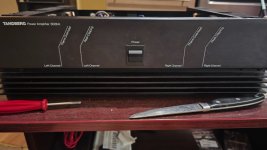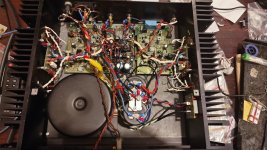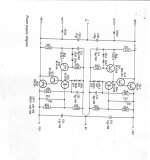Well,
This was one of the best solid state amplifiers from that time which was 30 years ago. TOTL from Tandberg, who's folks went on to work in and or found Electrocompaniet, Dynamic Precision, Hegel.
I have finally given up hope on it. The mistake was that I somewhat accidentally connected the high level positive outputs because I was "bi-amping" a two way speaker with each channel (was experimenting with DSP filters and direct connection to the amp), but didn't remove the positive jumper/bridge as I should have, but instead removed only the negative which makes no sense in retrospect. That's how I burned the right channel. It played, but only for a couple of minutes. Left is still functional. I tried replacing the resistors that burned, but the problem persisted. I replaced all the shorted transistors, but the resistors are still heating up and somewhere there is too much current where there shouldn't be. But I'm out of ideas.
That's why I want to salvage what I have which is the power supply, the heatsink and the box, the Elna power supply capacitors (two 80V 15k uF each) and make a DIY amp perhaps reusing these components. Hopefully you guys can recommend me something that's worth making. I could talk about the sound that I like, but I just want anything that's worth exploring. Energetic, kicky, clear, dizzyingly enjoyable, extraordinary... Low noise floor would be also pretty awesome. I would like to use Renesas TO-3p MOSFETs from one of the members here. Four per channel perhaps as in the original amp.
Either integrated or purely power amplifier projects would be of interest. Is there something extraordinary that wouldn't break one's Bank? What are the most expensive pieces in the puzzle?
And I'm just very interested in what projects you guys consider the most bang for the buck. I understand that people's tastes differ, but if there is some kind of Hall of Fame or top 5 of lateral MOSFET amps, I'm sure at least one of them would be what I'm looking for.
This was one of the best solid state amplifiers from that time which was 30 years ago. TOTL from Tandberg, who's folks went on to work in and or found Electrocompaniet, Dynamic Precision, Hegel.
I have finally given up hope on it. The mistake was that I somewhat accidentally connected the high level positive outputs because I was "bi-amping" a two way speaker with each channel (was experimenting with DSP filters and direct connection to the amp), but didn't remove the positive jumper/bridge as I should have, but instead removed only the negative which makes no sense in retrospect. That's how I burned the right channel. It played, but only for a couple of minutes. Left is still functional. I tried replacing the resistors that burned, but the problem persisted. I replaced all the shorted transistors, but the resistors are still heating up and somewhere there is too much current where there shouldn't be. But I'm out of ideas.
That's why I want to salvage what I have which is the power supply, the heatsink and the box, the Elna power supply capacitors (two 80V 15k uF each) and make a DIY amp perhaps reusing these components. Hopefully you guys can recommend me something that's worth making. I could talk about the sound that I like, but I just want anything that's worth exploring. Energetic, kicky, clear, dizzyingly enjoyable, extraordinary... Low noise floor would be also pretty awesome. I would like to use Renesas TO-3p MOSFETs from one of the members here. Four per channel perhaps as in the original amp.
Either integrated or purely power amplifier projects would be of interest. Is there something extraordinary that wouldn't break one's Bank? What are the most expensive pieces in the puzzle?
And I'm just very interested in what projects you guys consider the most bang for the buck. I understand that people's tastes differ, but if there is some kind of Hall of Fame or top 5 of lateral MOSFET amps, I'm sure at least one of them would be what I'm looking for.
Last edited:
The PCB on the right sustained most of the damage although the center one had a couple of transistors burned also. Replacing all the transistors that were obviously bad unfortunately did not resolve the problem. The resistors at the bottom are still heating up... Something went wrong and I'm afraid that even if I'm able to restore it to a working condition, it's never really going to be what it's supposed to be, because so many components have been damaged.
Attachments
Coool! Not sure how I would use it though.
Yeah, Jacques, it looks pretty messy from the factory.
I kinda think it's a lost cause at this point. Especially since I think so many resistors have lost their intended values that even if it works again, it's just not going to be what it's supposed to be. And I wouldn't be able to replace all of the components, that's just way too much work.
So, could somebody point me to a thread or give their opinion on what have been the top lateral MOSFET DIY power or integrated amplifiers in the recent decade or recent years. The knowledgeable members of this forum must know I imagine the best bang for your buck projects. If I knew what to look for, I would be able to research them individually and decide which one appeals to me the most. Thanks for any advice guys 🙏🏻
So, could somebody point me to a thread or give their opinion on what have been the top lateral MOSFET DIY power or integrated amplifiers in the recent decade or recent years. The knowledgeable members of this forum must know I imagine the best bang for your buck projects. If I knew what to look for, I would be able to research them individually and decide which one appeals to me the most. Thanks for any advice guys 🙏🏻
You have a fairly high supply voltage on it (74Vdc) you cannot put what you want in the way of amplifier modules.
if you want something without problem, cheap is known, I recommend the EBB modules on ebay.uk
https://www.ebay.fr/itm/361490296514
if you want something without problem, cheap is known, I recommend the EBB modules on ebay.uk
https://www.ebay.fr/itm/361490296514
Man, I'm such a noob at this. I didn't even consider that that was an option.
Also how did you come up with the 74V figure? I only see 88V, 64V and 72V in the power supply diagram. I tried looking up the transformer by the part number, but came up with nothing. Tried to open the transformer case, but it's riveted.
Also how did you come up with the 74V figure? I only see 88V, 64V and 72V in the power supply diagram. I tried looking up the transformer by the part number, but came up with nothing. Tried to open the transformer case, but it's riveted.
Attachments
The input stage is 74Vdc, the driver stage is 88Vdc and the Mosfet output stage is 64Vdc.
The power supply schematic is the regulator for the input stage.
The power supply schematic is the regulator for the input stage.
I'm sorry if this is a stupid question but all those different voltage rails are coming from the same transformer, right, just different coil loop ratios? I'm trying to figure out if I could use this transformer for a F5 turbo project. The capacitors are 15k uF each, so that sounds right around what is required for F5 turbo. I'm not exactly sure if heatsinks are adequate for 4 pairs of mosfets. But I could figure something out.
Also, I still can't figure out where you guys found the 74 volt DC value. What is the 72 volt representative of then?
Also, I still can't figure out where you guys found the 74 volt DC value. What is the 72 volt representative of then?
But people have made F5 turbos with high voltage rails. Does 64 Volts really sound that crazy? As for heatsinks, what if I use two pairs - one for each channel - of very efficient MOSFETs with 0.21 Ohm resistance like IXTH20N65X. What is acceptable operating temperature range or is it designed not to exceed like 55C? Thermal management I think I could figure out. Add more heat sinks if necessary.
If you want to build an F5 Turbo I suggest you build one from scratch, you're not going to be able to re-use anything from your 3026A. The F5 is Class A, the 3026A is Class AB.
You should reconsider repairing your 3026A, it is a very good amplifier.
You should reconsider repairing your 3026A, it is a very good amplifier.
Yes, indeed I'm looking at the Wolverine as my final choice!
Can you please explain to me why there is ±64, 72, 74 and 88 Vdc rails on my old amp? Are all of these coming from the different sections of the same transformer?The MOSFETs are running on 64, so would I just use this section for all the operations in Wolverine? Is there a way I could figure out the the VA rating if theres only a number written on it, it's bolted shut and I can't find it on the internet? The original amp was 150W into 8ohm, 1kW peaks into very low impedance loads, 210W rated continuous power into 4ohm.
Can you please explain to me why there is ±64, 72, 74 and 88 Vdc rails on my old amp? Are all of these coming from the different sections of the same transformer?The MOSFETs are running on 64, so would I just use this section for all the operations in Wolverine? Is there a way I could figure out the the VA rating if theres only a number written on it, it's bolted shut and I can't find it on the internet? The original amp was 150W into 8ohm, 1kW peaks into very low impedance loads, 210W rated continuous power into 4ohm.
For mosfet power amplifiers its quiet common to have the input stage voltage rails above the output stage, this is due to the voltage on the Gate needs to be several volts above the Source for current to flow from Drain to Source.
The input stage is 10volts (64volts) above the output stage (74volts), also the input stage voltage is regulated and is fed from the 88volt winding from the transformer.
The transformer has different taps on the secondary winding, +/-64 and +/-88v, after rectification. The +/-88v secondary will be a low current winding.
btw, I suggest you check the mechanical dimensions of the wolverine amp and the required heatsink sizing, as I mentioned in a previous post you cant really re-use anything from your current amplifier, the amplifiers you are considering to build is really starting from scratch meaning new chassis, power supply, heatsinks and amplifier boards.
The input stage is 10volts (64volts) above the output stage (74volts), also the input stage voltage is regulated and is fed from the 88volt winding from the transformer.
The transformer has different taps on the secondary winding, +/-64 and +/-88v, after rectification. The +/-88v secondary will be a low current winding.
btw, I suggest you check the mechanical dimensions of the wolverine amp and the required heatsink sizing, as I mentioned in a previous post you cant really re-use anything from your current amplifier, the amplifiers you are considering to build is really starting from scratch meaning new chassis, power supply, heatsinks and amplifier boards.
Oh, I thought you meant only for class A that nothing could be repurposed. I'll check the physical size of the chassis required and heatsinks. The Tandberg is pretty hefty.
I thought the voltages for the Wolverine were similar enough to use the power supply. It's a pity if none of the high value components can be adpated to the Wolverine design. But not even the power supply caps? Damn. If none of this is good for Wolverine, I'm looking at a few hundred increase in costs.
Perhaps I can try rebuilding the Tandberg from scratch with all new components despite it's rather great complexity. Make a better amp at the end of the day than I had and spend less than building Wolverine from scratch. But Tandberg I'm already familiar with. It's great, but I'd love to learn more of what the world of amplification has to offer. I'll never forget how it sounded, it's already etched into my brain.
I thought the voltages for the Wolverine were similar enough to use the power supply. It's a pity if none of the high value components can be adpated to the Wolverine design. But not even the power supply caps? Damn. If none of this is good for Wolverine, I'm looking at a few hundred increase in costs.
Perhaps I can try rebuilding the Tandberg from scratch with all new components despite it's rather great complexity. Make a better amp at the end of the day than I had and spend less than building Wolverine from scratch. But Tandberg I'm already familiar with. It's great, but I'd love to learn more of what the world of amplification has to offer. I'll never forget how it sounded, it's already etched into my brain.
- Home
- Amplifiers
- Solid State
- DIY from the remains of Tandberg 3026A


